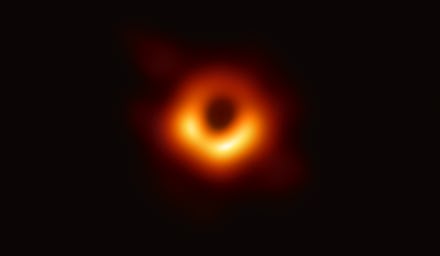You can see the whole universe by looking into a black hole, according to new research

It isn't advisable to stare straight into a black hole, but if you did, you might find some particularly dazzling sights. If you looked closely enough, you may just see the entire universe, according to a recent edition of the journal Science Advances. Though astronomers shocked (most) observers with the first official photograph of a black hole just last year, their new findings reveal there's more to that photo than originally reported.
Turns out light from stars and galaxies are reflected in the black hole, spiraling around it like an infinite spool of thread. Contrary to popular belief, it doesn't look like a scary death vacuum threatening to swallow everything we know and love.
"The image of a black hole actually contains a nested series of rings," explained study author Michael Johnson of the Harvard-Smithsonian Center for Astrophysics. As a member of the team operating the Event Horizon Telescope, he worked alongside others to propose a new method that could potentially allow viewers to see more than just the infinite blackness of these holes in spacetime.
The Event Horizon Telescope is actually a network of telescopes, part of the first radio telescope that brought us that first photo of a black hole last April. Scientists were able to see the rings that Johnson mentioned last year, but at the time they simply weren't able to interpret them from the rest of the image due to low resolution.
The team of scientists responsible for the new study worked to add additional radio telescopes in space to the network that already existed in a bid to help make it simpler to see into these rings. As a result, they were able to see the stunning, ribboning images mentioned above.
"Understanding the intricate details of this historic experimental observation has forced theorists like myself to think about black holes in a new way," said Harvard's Andrew Strominger, co-author of the original study. While there's still plenty of work to be done on the network of telescopes, this is still an intriguing way for scientists to continue studying what's actually going on when it comes to the enigmatic black holes we spend so much time fussing over and wondering how to study more effectively.
"This is a way of studying exactly what lies at the centers of galaxies, in a way that we can never learn from larger scale measurements such as the orbits of stars or gas," said Johnson.
It's not perfect just yet, of course, and it may never be. But it's definitely a start, and when it comes to understanding the celestial bodies and what's out there adorning the heavens, that's the best we can hope for at present. Who knows? It could actually be like we thought it was in 2001: A Space Odyssey: all full of stars.